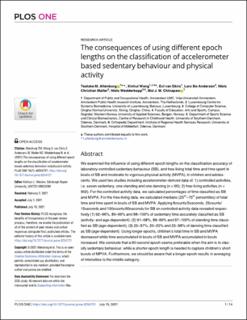| dc.contributor.author | Altenburg, Teatske M. | |
| dc.contributor.author | Wang, Xinhui | |
| dc.contributor.author | van Ekris, Evi | |
| dc.contributor.author | Andersen, Lars Bo | |
| dc.contributor.author | Møller, Niels Christian | |
| dc.contributor.author | Wedderkopp, Niels | |
| dc.contributor.author | Chinapaw, Mai J.M. | |
| dc.date.accessioned | 2022-02-14T10:05:35Z | |
| dc.date.available | 2022-02-14T10:05:35Z | |
| dc.date.created | 2022-01-25T22:59:34Z | |
| dc.date.issued | 2021 | |
| dc.identifier.citation | Altenburg, T. M., Wang, X., van Ekris, E., Andersen, L. B., Møller, N. C., . . . Chinapaw, M. J. M. (2021). The consequences of using different epoch lengths on the classification of accelerometer based sedentary behaviour and physical activity. Plos One, 16(7): e0254721. | en_US |
| dc.identifier.issn | 1932-6203 | |
| dc.identifier.uri | https://hdl.handle.net/11250/2978695 | |
| dc.description.abstract | We examined the influence of using different epoch lengths on the classification accuracy of laboratory-controlled sedentary behaviour (SB), and free-living total time and time spent in bouts of SB and moderate-to-vigorous physical activity (MVPA), in children and adolescents. We used two studies including accelerometer-derived data of: 1) controlled activities, i.e. seven sedentary, one standing and one dancing (n = 90); 2) free-living activities (n = 902). For the controlled-activity data, we calculated percentages of time classified as SB and MVPA. For the free-living data, we calculated medians (25th–75th percentiles) of total time and time spent in bouts of SB and MVPA. Applying 8counts/5seconds, 25counts/15seconds and 100counts/60seconds for SB on controlled-activity data revealed respectively (1) 92–96%, 89–99% and 98–100% of sedentary time accurately classified as SB (activity- and age-dependent); (2) 91–98%, 88–99% and 97–100% of standing time classified as SB (age-dependent); (3) 25–37%, 20–25% and 25–38% of dancing time classified as SB (age-dependent). Using longer epochs, children’s total time in SB and MVPA decreased while time accumulated in bouts of SB and MVPA accumulated in bouts increased. We conclude that a 60-second epoch seems preferable when the aim is to classify sedentary behaviour, while a shorter epoch length is needed to capture children’s short bursts of MPVA. Furthermore, we should be aware that a longer epoch results in averaging of intensities to the middle category. | en_US |
| dc.language.iso | eng | en_US |
| dc.publisher | PLoS | en_US |
| dc.rights | Navngivelse 4.0 Internasjonal | * |
| dc.rights.uri | http://creativecommons.org/licenses/by/4.0/deed.no | * |
| dc.title | The consequences of using different epoch lengths on the classification of accelerometer based sedentary behaviour and physical activity | en_US |
| dc.type | Peer reviewed | en_US |
| dc.type | Journal article | en_US |
| dc.description.version | publishedVersion | en_US |
| dc.rights.holder | © 2021 Altenburg et al. | en_US |
| dc.source.volume | 16 | en_US |
| dc.source.journal | PLOS ONE | en_US |
| dc.source.issue | 7 | en_US |
| dc.identifier.doi | 10.1371/journal.pone.0254721 | |
| dc.identifier.cristin | 1989979 | |
| dc.source.articlenumber | e0254721 | en_US |
| cristin.ispublished | true | |
| cristin.fulltext | original | |
| cristin.qualitycode | 1 | |

